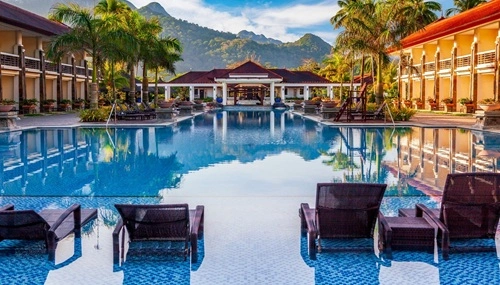India’s hotel industry has entered an exciting new phase in 2025. Following the post-pandemic recovery, the sector is witnessing remarkable growth driven by a surge in domestic tourism, increasing foreign tourist arrivals, and robust business travel. With government support through schemes like Dekho Apna Desh, rising disposable incomes, and improved infrastructure, the Indian hotel industry is regaining its momentum with confidence and innovation.
According to the Federation of Hotel & Restaurant Associations of India (FHRAI), the hotel sector’s revenue in India grew by over 22% in FY 2023–24, and the average occupancy rate has reached nearly 70% in 2025 — its highest since pre-pandemic levels. International hotel chains are expanding their footprint, while home-grown brands like Indian Hotels Company (Taj), Oberoi, ITC Hotels, and Lemon Tree are strengthening their portfolios through mid-scale and budget segments. The rise of spiritual tourism, eco-friendly stays, digital bookings, and experiential travel is redefining the hospitality landscape in the country.
This SWOT analysis presents a deep dive into the strengths, weaknesses, opportunities, and threats shaping the hotel industry in India as it navigates a high-growth, competitive environment.

Strengths
1. Diverse Tourist Base and Rich Cultural Heritage
India’s vast cultural, historical, and geographical diversity attracts millions of domestic and international tourists each year. From Himalayan retreats to beach resorts, heritage palaces to business hotels, the variety of offerings enables hoteliers to cater to every traveler’s need and preference.
2. Strong Domestic Travel Demand
Domestic tourism has become a strong pillar of the Indian hotel industry. Driven by a growing middle class, improved road and air connectivity, and rising aspirations, more Indians are travelling for leisure, pilgrimage, and weekend getaways, boosting occupancy across hotel segments.
3. Growing Brand Presence and Global Tie-ups
India has seen a significant influx of international hotel chains such as Marriott, Hilton, Accor, and Radisson expanding into Tier 2 and Tier 3 cities. Simultaneously, Indian brands like Taj, Oberoi, and Fortune have gained recognition for premium hospitality and global-standard service, enhancing India’s brand value in tourism.
4. Government Support and Policy Reforms
The Indian government is actively promoting tourism through policies like the National Tourism Policy 2023, Incredible India 2.0, and the Dekho Apna Desh campaign. Initiatives like e-visa facilitation, infrastructure development, and investment subsidies are creating a favorable ecosystem for hotel growth.
5. Rise of Digitalization and Tech-Enabled Services
With the rise of online booking platforms, AI-powered customer service, smart rooms, and mobile check-ins, the industry is leveraging technology to improve efficiency and enhance customer experience. Brands that adopt these tools are witnessing increased customer satisfaction and loyalty.
Weaknesses
1. High Operating Costs and Seasonal Dependency
Running a hotel in India involves high fixed costs including property maintenance, staff salaries, utilities, and licenses. Additionally, many hotels, especially in tourist regions, face seasonality challenges with fluctuating occupancy, leading to revenue instability.
2. Skilled Workforce Shortage
Despite a large labor pool, the hotel industry in India faces a shortage of trained and experienced hospitality professionals. Staff retention, training gaps, and lack of consistent service standards in mid-range and budget hotels affect overall service quality.
3. Fragmented Market Structure
A large share of hotels in India remains unorganized or independently operated. This fragmentation creates inconsistencies in pricing, service standards, and customer expectations, and limits scalability for small players without brand affiliation.
4. Infrastructural Constraints in Remote Areas
While demand is rising in Tier 2 and spiritual destinations, inadequate infrastructure — such as poor road access, lack of sanitation, or limited connectivity — can hinder the full potential of hospitality development in those areas.
Opportunities
1. Boom in Spiritual and Experiential Tourism
Places like Varanasi, Ayodhya, Rishikesh, and Shirdi are witnessing record tourist arrivals due to improved infrastructure and religious significance. Hotels catering to pilgrims and spiritual seekers — with wellness, vegetarian cuisine, and serene stays — have immense potential.
2. Expansion in Tier 2 and Tier 3 Cities
As metros saturate, hotel brands are eyeing smaller cities with growing business activity, educational institutions, and rising incomes. Brands like Ginger, FabHotels, and OYO are leading this mid-market expansion with scalable, standardized offerings.
3. Eco-Friendly and Sustainable Hospitality
Environmentally conscious travel is growing fast, and hotels that adopt green practices — such as solar energy, water recycling, and plastic-free operations — are gaining preference, especially among millennials and foreign tourists.
4. Medical and Wellness Tourism
India is a hub for affordable medical treatments, Ayurveda, and wellness therapies. Cities like Kochi, Bengaluru, and Pune are attracting global patients, creating demand for clean, comfortable, and service-oriented hotels near hospitals and wellness centres.
5. MICE and Bleisure Travel
The rise in corporate events, meetings, and exhibitions (MICE), coupled with the trend of combining business with leisure (bleisure), opens up significant scope for city hotels, resorts, and convention centres.
Threats
1. Rising Competition from Alternate Accommodations
The growth of platforms like Airbnb, StayVista, and homestay aggregators offers travelers low-cost, personalized, and immersive options that often undercut hotel pricing, especially in leisure destinations.
2. Economic and Political Volatility
Fluctuations in currency, inflation, or political unrest—both globally and domestically—can directly impact tourist arrivals and business travel. Regional disruptions (like protests or natural disasters) can affect hotel revenues in specific areas.
3. Health and Safety Concerns Post-Pandemic
While tourism has bounced back, travelers remain cautious about cleanliness, hygiene, and safety. Any lapse or negative news around health hazards can hurt a hotel’s reputation in today’s digitally connected world.
4. Regulatory Hurdles and Taxation
Multiple licenses, inconsistent state-wise regulations, and complex tax structures (such as varying GST rates) continue to pose bureaucratic challenges for hotel operators and investors.
Conclusion
The Indian hotel industry in 2025 is vibrant, competitive, and poised for long-term growth. With a diverse demand base, strong domestic tourism, supportive government policies, and rapid digital adoption, the sector holds immense promise. While challenges remain in terms of infrastructure, workforce, and competition from alternative accommodations, the industry’s resilience and innovation are driving its success story.
As India continues to emerge as a global tourist and business hub, the hospitality sector will be pivotal in shaping traveler experiences. With the right balance of sustainability, inclusivity, and technology, the hotel industry in India is well-equipped to welcome the next wave of travelers with warmth, efficiency, and world-class service.

Meet Suhas Harshe, a financial advisor committed to assisting people and businesses in confidently understanding and managing the complexities of the financial world. Suhas has shared his knowledge on various topics like business, investment strategies, optimizing taxes, and promoting financial well-being through articles in InvestmentDose.com


